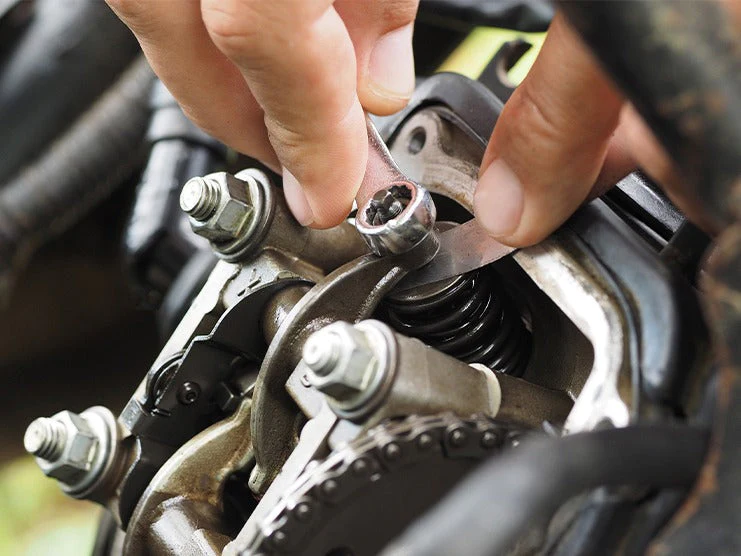Valve adjustment is essential for motorcycle maintenance since it is responsible for optimal engine performance and longevity. Yet many riders overlook or neglect this task, putting their motorcycle engines at risk. Every rider needs to know the basics of valve adjustment, including the required tools, the recommended schedule, and which professionals to ask for help. Understanding the importance of valve adjustment will help keep the engine running smoothly and keep it from becoming damaged. This blog will discuss the importance of valve adjustment for motorcycles, the consequences of neglecting this task, and how to correctly adjust valves.
Table of Content
1. The Role of Motorcycle Engine Valves
What is a Valve?
In motorcycles, a valve is an engine component that helps regulate fuel and airflow throughout the combustion chamber. A motorcycle engine typically has two types of valves:
- Intake Valves
- Exhaust Valves
The intake valve opens to allow air and fuel to enter the combustion chamber. Meanwhile, the exhaust valve opens to allow exhaust gases to exit the combustion chamber after combustion is complete. These valves operate on a camshaft synchronized with the rotation of the engine’s crankshaft.
The valves must be adjusted to ensure that they open and close at the correct intervals, ensuring the engine operates efficiently. If the valves are not adjusted properly, they may not open and close fully, leading to reduced engine performance and power.
The valves also play a role in braking. When the throttle is closed, the intake valves close and the engine’s momentum causes the pistons to compress the air and fuel mixture. This compression creates resistance that causes the motorcycle to slow down.
2. What is Valve Adjustment and Why is it Important?

Valve Clearance or Lash
Valve clearance, also known as valve lash, is the gap between the rocker arm and valve or camshaft that opens and closes the valve. In motorcycles, valve clearance is adjusted to ensure the valve opens and closes at the correct time with the correct amount of lift. Incorrect valve clearance can cause various issues, including reduced power, poor fuel economy, increased emissions, and engine damage. Over time, valve clearance can change due to wear and tear, making it essential to check periodically and apply adjustments.
What is Valve Adjustment?
Valve adjustment is a maintenance procedure that involves adjusting the clearance between the valve stem and the rocker arm or crankshaft.
It's important to note that different types of engines require different ways to adjust valve clearance. Therefore, consult your motorcycle's owner's manual for specific instructions.
Additionally, if you're uncomfortable performing this type of maintenance yourself, it's best to leave it to a professional mechanic.
Why is it Important?
Valve adjustment is important because it ensures the valves operate correctly, which affects the engine’s performance. If the valve lash is too loose, the valve may not open and close fully, resulting in poor engine performance and decreased power. There will be compression loss and overheating if the valve lash is too loose or too tight.
In addition to improving engine performance, valve adjustment can extend an engine’s lifespan. Neglecting valve adjustment can lead to engine damage, such as bent valves or broken camshafts.
3. Signs that Your Motorcycle's Valves Need Adjustment
There are several signs that may indicate that your motorcycle's valves need adjustment, including:
| Signs that Your Motorcycle's Valves Need Adjustment | ||
|---|---|---|
| Sr. no. | Sign | Description |
| 1 | Decreased Power | Valves that cannot open and close properly will cause reduced engine power and performance. |
| 2 | Poor Idle | If your motorcycle is idling poorly or unevenly. An incorrect valve clearance can cause the engine to run poorly at low RPMs. |
| 3 | Ticking or Clicking Sound | A ticking or clicking sound coming from the engine. This noise is caused by the valve train components hitting each other due to improper clearance. |
| 4 | Hard Starting | If your motorcycle has difficulty starting. Incorrect valve clearance can make it harder for the engine to turn over. |
| 5 | Engine Overheating | As the valve regulates the flow of air and fuel, it can cause the engine to overheat when valves do not open and close properly. |
| 6 | Reduced Fuel Efficiency | If the valves are not properly opening and closing, it can cause the engine to run less efficiently. This can result in reduced fuel efficiency and increased emissions. |
If you notice any of these signs, it is important to have your motorcycle’s valves checked and adjusted as needed. Neglecting valve adjustment can lead to serious engine damage and decreased performance.
4. Benefits of Properly Adjusted Valves for Motorcycle Performance
Here are the benefits of having your motorcycle’s valves properly adjusted:
Increased Power
Properly adjusted valves can increase engine power and performance since they ensure maximum air and fuel flow into the engine.
Better Fuel Efficiency
When the valves are properly adjusted, the engine runs more efficiently and has better fuel economy and reduced emissions.
Smoother Idle
Properly adjusted valves can lead to smoother idle and overall engine operation.
Reduced Engine Noise
Properly adjusted valves can reduce engine noise and vibrations, providing a more comfortable ride.
Extended Engine Life
Neglecting valve adjustment can cause engine damage, such as bent valves or broken camshafts. By properly adjusting the valves, you can extend the engine’s lifespan.
Better Engine Braking
Properly adjusted valves can improve engine braking by ensuring the correct intake and release of air and fuel during deceleration.
5. How Often Should You Adjust Your Motorcycle's Valves?
How frequently you adjust the valves on a motorcycle varies depending on the make and model, the type of the engine, and the level of use. It is important to follow the manufacturer’s recommended maintenance schedule for your specific motorcycle since it provides the best timeline on when to adjust the valves.
Generally, most motorcycles require valve adjustment at least once every 12,000 to 15,000 miles or every two to three years, depending on which comes first. However, some motorcycles may require valve adjustment at shorter intervals between every 6,00 to 8,00 miles, particularly those with high-performance engines or heavily used.
It is also important to note that some motorcycles have hydraulic valve lifters or other components that do not require regular valve adjustment. In these cases, still follow the manufacturer’s recommended maintenance schedule, though you may not need to adjust the valves.
6. How to Adjust Valves on Your Motorcycle?
Adjusting the valves on a motorcycle requires some mechanical skill and experience. It is recommended that this procedure is performed by a professional mechanic, especially if you are not familiar with the inner workings of your motorcycle engine. However, if you are experienced and confident in providing maintenance, here are the steps for adjusting the valves:
- Consult your motorcycle owner’s manual for instructions on how to access the valve train and adjust the valves. You will need to remove the fuel tank, cylinder head cover, and other components to gain access to the valve train.
- Allow your engine to cool down before attempting to inspect the valve clearance. Hot engine components can cause burns or injury.
- Remove the seat and fuel tank to gain access to the valve cover.
- Loosen the locknut on the rocker arm or camshaft adjuster screw, depending on the type of valve train your motorcycle engine has.
- Remove the valve cover using the appropriate tools. Depending on your bike model, you may need to remove other components first.
- Locate the camshaft and rocker arms. These components will vary depending on the engine configuration of your motorcycle. Refer to the owner's manual for proper identification.
- Identify the intake and exhaust valves labeled on the engine.
- Using a feeler gauge, check the valve clearance by sliding it between the rocker arm and the valve. The gauge should slide in with slight resistance.
- In case of too tight valve clearance, loosen the lock nut on the adjuster screw and turn the screw until it is the correct clearance. If it is too loose, tighten the lock nut and turn the adjuster screw until it is the correct clearance.
- Use a screwdriver or wrench to turn the adjuster screw until the valve lash is within the manufacturer’s recommended specifications.
- Hold the adjuster screw and tighten the locknut to secure the adjustment.
- Repeat this process for each valve, making sure to adjust each valve to the manufacturer’s recommended specifications.
- Once all the valves have been adjusted,reassemble any components removed to access the valve train.
- Start the engine and listen for any abnormal noises. If necessary, recheck the valve lash and make further adjustments.
7. Importance of Seeking Professional Help for Valve Adjustment
Adjusting the valves is a complex task that requires specialized knowledge, experience, and tools. Here are some reasons why you should seek professional help for valve adjustment:
-
Safety:
Adjusting the valves requires working with engine components that can be hot, sharp, or under high pressure. Professionals have the experience and tools to handle these components safely, reducing the risk of injury. -
Accuracy:
Adjusting the valves requires precise measurements and adjustments to ensure that the engine is running optimally. Professionals have the training and tools to make accurate adjustments, which can improve engine performance and fuel economy. -
Warranty:
If your motorcycle is under warranty, adjusting the valves yourself could void the warranty. Seeking professional help ensures the work is performed according to the manufacturer's specifications while keeping the warranty valid. -
Time and Effort:
Adjusting the valves can be time-consuming and complex, especially if you are not used to providing motorcycle maintenance. Seeking professional help can save you time and effort. -
Cost:
While seeking professional help for valve adjustment may be expensive, it can ultimately save you money in the long run. Improper valve adjustment can cause engine damage or poor performance, which can be even more costly to repair.
8. Tools Required for Valve Adjustment
Valve adjustment is a precision task that requires specialized tools to measure and adjust valve clearance. Here are some of the tools used in valve adjustment:
| Tools Required for Valve Adjustment | ||
|---|---|---|
| Sr. No. | Tool | Function |
| 1 | Feeler Gauge | This tool measures the gap between the valve stem and the rocker arm or camshaft. It is important to use a feeler gauge with the correct thickness specified by the manufacturer for the appropriate engine model. |
| 2 | Wrenches and Sockets | Depending on the motorcycle model, you may need a set of wrenches or sockets to remove the valve cover, spark plug, and other components to access the valve train. |
| 3 | Torque Wrench | This tool tightens the bolts to the manufacturer's recommended torque specifications. |
| 4 | Valve Spring Compressor | This tool compresses the valve spring, allowing you to remove and install the valve keepers without damaging the valve or spring. |
| 5 | Tappet Adjusting Tool | This tool turns the adjuster screw without damaging the tappet or adjuster. |
| 6 | Valve Grinding Paste | This tool grinds the valve and seat together to create a seal. |
| 7 | Valve Lapping Tool | This tool connects the valve to the valve seat, creating a smooth surface and a seal. |
If you are not familiar with the tools required for valve adjustment, it is recommended that you ask an expert mechanic for help.
9. Conclusion
During motorcycle maintenance, adjusting the valves will ensure optimal engine performance, keeping the engine running smoothly for years. Neglecting valve adjustment can cause engine damage, poor performance, and safety hazards. It is important to follow the manufacturer's recommended valve adjustment schedule and use the proper tools to perform this task correctly.
While valve adjustment can be complex and time-consuming, seeking professional help can ensure the maintenance is done correctly. A qualified mechanic has the expertise, experience, and specialized tools necessary to adjust the valves to ensure optimal engine performance. If you want to improve your motorcycle’s aesthetics, you can add Viking Bags Saddlebags, fairings, handlebars, seats, crash bars, luggage racks, and sissy bars.













Leave a comment
All comments are moderated before being published.
This site is protected by hCaptcha and the hCaptcha Privacy Policy and Terms of Service apply.